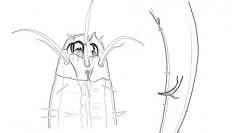

 European Journal of Taxonomy
787 (17) - Pages 17-31
European Journal of Taxonomy
787 (17) - Pages 17-31Three new species of Mesacanthion Filipjev, 1927 were found along Patagonian coasts (Argentina). Mesacanthion bifidum sp. nov. is characterized by short labial and cephalic setae, onchia of equal size, spicule arcuate, and gubernaculum with caudal apophysis, ending in two teeth. The species is related to M. virile (Ditlevsen, 1930) De Coninck & Schuurmans Stekhoven, 1933. However, the spicules and gubernaculum of both species are different in shape. Mesacanthion longigubernaculum sp. nov. is characterized by its long and slender body, striated cuticle, relatively long cephalic and cervical setae, onchia of different sizes, amphidial fovea lentil-shaped, spicule arcuate, gubernaculum surrounding the spicule, and tail conical-cylindrical with terminal setae. Mesacanthion sanantoniensis sp. nov. is characterized by its long and stout body, striated cuticle, long cephalic setae, onchia of different sizes, amphidial fovea pouch-shaped, spicule arcuate, gubernaculum with dorsal apophysis, and tail conical without terminal setae. Following the key of Jeong et al. (2019), the last two species are related to M. pali Wieser, 1959 and M. longissimesetosum Wieser, 1953, so we provide a key to differentiate the four species.
Free-living marine nematodes, diversity, taxonomy, Patagonia, coastal area